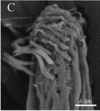Family Xyalidae
Rev.
07/26/2025
Nematoda
Chromadorea
Chromadoria
Monhysterida
Monhysterina
Sphaerolaimoidea
Xyalidae Chitwood, 1951
 |
Various configurations of cephalic setae in family Xyalidae:
Characteristic 1:
Inner labial seta visible or invisble
Characteristic 2:
Outer labial setae prwesent or absent
Characteristic 3:
either zero, 4, or 8 cepalic setae
Characteristic 4:
zero or 1 supplementary cephalic setae
adapted from Nicholas and Trueman, 2002
|
 |
|
Pseudosteineria sp (Xyalidae): Cephalic
setae
(from Cesaroni et al., 2017) |
|
- A widespread family of mostly
marine free-living nematodes.
- Free-living nematodes of marine and brackish
water; often among the most abundant of the nematode taxa in an
environment..
- Body length 0.5-2 mm.
- Cuticle finely striated and with
long somatic setae.
- Ocelli sometimes present.
- Mouth cavity simple, funnel-shaped, denticles either
absent or minute.
- 6+4 sensillae
almost always situated very close, for example, the 2nd annule with 6 cephalic setae
anf the third with 4. There may be with additional cephalic setae.
- Esophagus cylindrical.
- Female monodelphic prodelphic, vulva at
60-65% of body length. Per Lorenzen (1994, in didelphic forms, the
anterior gonad is always on the left of the intestine and the posterior
gonad on the right.
- Male
with two testes, anterior teatis on left and posterior teatis on right side
of the intestine.
- Males occur commonly in most genera.
- Circular
amphids,
some marine forms with spiral amphids.
- Tail elongate conoid, terminated in a short spinneret..
- Many of the species descriptions of nematodes made in the
20th century were made based on very few specimens with relatively few
characters of taxonomic value (Venekey et al., 2014). Consequently,
taxonomic reviews and revisions are difficult,
The Xyalidae, are considered, with the
Sphaerolaimidae
to be in the superfamily Sphaerolaimoidea of the Order
Monhysterida. Other superfamilies in the Monhysterida are Monhysteroidea
(family Monhysteridae) and Siphonolaimoidea (families
Siphonolaimidae
and
Linhomoeidae). One usually
consistent feature is the possesion of a single out-stretched ovary in
female. However, assignment of families to superfamilies varies with authors and
through time (Lorenzen, 1978;
Lorenzen, 1994; Nicholas and Trueman, 2002).
References:
Cesaroni, L. Guidi, L., Balsamo, M., Semprucci, F.
2017. Scanning electron microscopy in the taxonomical study of free-living
marine nematodes. Microscopie 28:6970
Fonseca, G., Bezerra, T.M. 2014. 7.14 Order Monhysterida in A.
Schmidt-Rhaesa. Handbook of Zoology, Gastrotricha, Cycloneuralia and Gnathifers,
Vol 2. Nematoda. De Gruyter, Berlin. 759p
Lorenzen, S. 1977. Revision det Xyalidae (freilebende Nematoden) auf der
Grundlage einer kritischen Analyse von 56 Arten aus Nord- und Ostsee. Veroff
Inst Meeresforsch Bremerh 16:197-261.
Lorenzen, S. 1978. The system of the Monhysteroidea (Nematodes) – a new
approach. Zoologishe Jahrbücher Systematik 105: 515-536.
Lorenzen S 1994. The phylogenetic systematics of free-living nematodes.The
Ray Society Institute, London, n.162
Nicholas, W.L. and Trueman, J.W.H. 2002. The taxonomy of the family Xyalidae
Chitwood, 1951 (Monhysterida: Nematoda): a cladistic analysis. Nematology
4:453-470.
Venekey, V., Gheller, P.F., Maria , T.F., Brustolin, M.C., Kandratavicius ,
N., Vieira , D.C., Brito, S., Souza, G.S., Fonseca, G. 2014. The state of the art of
Xyalidae (Nematoda, Monhysterida) with reference to the Brazilian records.
Marine Biodiversity DOI 10.1007/s12526-014-0226-3
Return to Xyalidae Menu
Go to Nemaplex Main Menu

